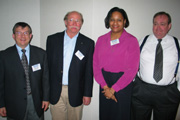UNMC hosted a regional conference of state administrators in May for the Biomedical Research Infrastructure Network (BRIN). The BRIN Central Region Meeting allowed BRIN coordinators from Nebraska, Kansas, North Dakota, South Dakota and Oklahoma to review their respective state programs with Fred Taylor, Ph.D., director of the Institutional Development Award (IDeA) Program.
 |
David Crouse, Ph.D., associate vice chancellor for academic affairs at UNMC; James Turpen, Ph.D., principal investigator of the BRIN grant in Nebraska; Sonya Williams, Ph.D., professor, Langston University department of biology and Oklahoma BRIN administrator; and Fred Taylor, Ph.D., director of the Institutional Development Award (IDeA) Program. |
“The IDeA Program is the funding source for the nation’s BRIN programs,” said James Turpen, Ph.D., professor in the UNMC department of genetics, cell biology and anatomy, and principal investigator of Nebraska’s BRIN. “Dr. Taylor’s visit was an exceptional opportunity for our region’s BRIN administrators to highlight each state’s progress. We received valuable feedback on how we’re doing and how to plan future directions that are going to work best in our respective states. The long-term goal is simple – increase NIH funding to each of our region’s BRIN institutions.”
IDeA grants strengthen an organization’s infrastructure and increase its capacity to conduct cutting-edge biomedical and behavioral research. The IDeA Program is located in the Division of Research Infrastructure of the National Center for Research Resources (NCRR) at the National Institutes of Health (NIH). NCRR provides IDeA grants to foster research within states that traditionally have not received significant levels of competitive funding from the NIH. Eligibility for the IDeA Program is limited to states that attained a success rate of less than 20 percent in competing for NIH grants or received less than $75 million on average in NIH support from 1997 to 2001. Nebraska is one of 24 states eligible for these funds.
UNMC is the lead institution in the Nebraska BRIN. There are seven undergraduate institutions and two community colleges that provide the pipeline for students to receive internships and advanced training in biomedical research. The undergraduate institutions include Creighton University, Wayne State College, Chadron State College, the University of Nebraska at Kearney, the University of Nebraska at Omaha, Doane College, Nebraska Wesleyan University, Western Nebraska Community College and Little Priest Tribal College.
Undergraduates chosen for the BRIN program receive their advanced biomedical training opportunities at one of three graduate institutions – UNMC, Creighton University or the University of Nebraska-Lincoln. The goals of the NE-BRIN are to train more undergraduates in research techniques; recruit them into graduate programs; and encourage them to stay in Nebraska and help develop the workforce needed to develop nationally competitive biomedical research.
 |
Dr. Sonya Williams, center, receives an overview of UNMC minority recruiting programs from Sherman Petite, specialist, UNMC Office of Student Equity and Multicultural Affairs (OSEMA) and Taneya Horton, administrative tech 1, student services administration. |
Nebraska joined the federal BRIN program in 2001, when the state successfully competed for a three-year, $6 million grant. The second and third years were supplemented by an additional $2 million, and Nebraska BRIN is currently seeking a five-year, $12.5 million grant to extend the program.
Dr. Taylor observed a bioinformatics presentation by investigators at the Eppley Science Institute and visited the Munroe-Meyer Institute’s Center for Human Molecular Genetics. He was given a demonstration of a state-of-the-art high speed microarrary printer that can prepare DNA slides at the rate of 100 slides per run containing 10,000 to 15,000 genes per slide. BRIN funds provided assistance for both core laboratories.
In his report to the conference, Dr. Turpen also noted that BRIN funds, for example, purchased a biomedical research “workhorse” for Wayne State University – a refrigerated centrifugation and autoclave repair machine.
That same equipment would have cost 18 to 20 months of the university’s entire department of life science budget.
“The major challenge for states in the central region is to develop a critical mass of research investigators,” Dr. Taylor said. “BRIN is a vital program because it goes to the undergraduate level and networks an entire state to encourage students to envision careers in the health sciences and biomedical research and provides the resources needed for equipment and faculty support.
“I think Nebraska is doing very well in the kinds of things that advance the growth of biomedical research and faculty. In particular, Nebraska has a real strong bioinformatics core. The presentation I received at UNMC on bioinformatics was impressive. UNMC has developed an excellent data base that is networked across the state.”
Dr. Taylor noted that his office maintains a strong communication link with all of its BRIN grantees through progress reports, e-mail and phone calls. Primarily, his job is to help problem solve local BRIN issues and help state BRIN administrators develop the best possible presentation when seeking NIH funds. He understands the complexity of seeking NIH funds – he has participated as a reviewer on national grant committees and he is a former full-time investigator. He did extensive research on temperature and blood flow to the skin and muscle, as part of studying the effects of cold acclimation on the performance of hyperbaric divers. His research also included working with elite Special Forces divers in U.S. Navy SEALs.
“I hope the BRIN program in Nebraska continues to interact with other institutions and students as it has been doing,” Dr. Taylor said. “Within each state, the NIH wants expanded collaboration between BRIN and COBRE (Centers of Biomedical Research Excellence). Then we want the BRIN’s to work together more on the regional level.
“It’s always a learning experience for me when I can visit academic institutions and meet local BRIN administrators. This regional conference is just the type of collaboration the NIH encourages. It’s all a part of building and advancing the biomedical medical research infrastructure and brain trust that will be needed to provide for the future of America’s health.”